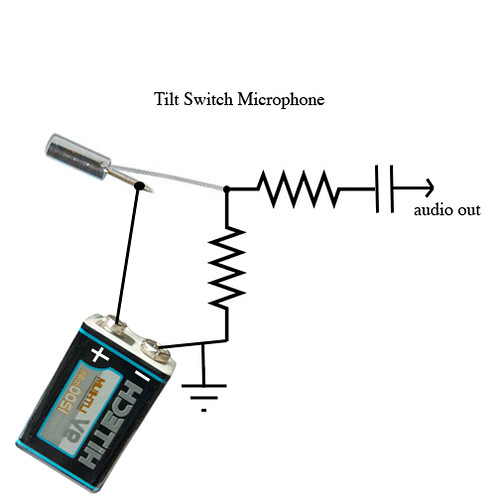Tilting here, tilting there, turning it on, turning it off... Okay tilt switches are boring.

It is a microphone?
Sure. An audio signal is just a fluctuating voltage. The reverse is often true; many varying voltage signals can treated as audio signal and be listened to. To use a tilt switch as an audio source you set it up to switch a voltage on and off and tilt away.

The resistor values are somewhat flexible. Start by trying 10k or 100k ohms for the resistor to ground and 1k for the other resistor. You can leave out the cap if you want a DC signal for control voltage use with a synth. Also make sure to use cheapo ball-in-a-can tilt switches instead of the mercury kind.

Above are part two quickly assembled "microphones." You may notice the needly spike on the right microphone and the uncut lead on the left one. I've found this can sometimes make mounting them easier. Which leads us to....
This is even shittier than I thought.
You knew there were going to at least a few quirks with this right? First off, it is more or less a contact microphone so you need to attach it directly to what you want to amplify. Also, the tilt switch only really reacts to vibrations from certain angles; the vibrations need to cause the ball-in-a-can to bounce in order to get an output that vaguely resembles what you want.
The best way to demonstrate the horrible nature of this microphone is to attempt to record some virtuosic guitar leads. The first three sound clips do just that. Chords first, then high notes, then low notes. The tilt switch was taped to the bridge of an acoustic guitar for the recording.
Earlier I mentioned that I leave one lead of the switch unclipped. This gave me the idea to use that lead as a needle for a record player. The records I have handy are scratched to shit but as these microphones turn everything into indistinguishable crunch, crackles, and pops I don't think it is too important. If you can't imagine a piano buried a mile under the crunch of the fourth clip, let's blame it on the scratched up record.
If you like getting carried away...
You don't even need to use a tilt switch to make a horrible microphone. I've had some fun replacing the tilt switch in this circuit with two pieces of tinfoil or a pie tin with a needle or slip of tinfoil on it. Any two conductive materials with the ability to jitter or bounce should work. There is a handful of homemade tilt switch articles online too.
No comments:
Post a Comment